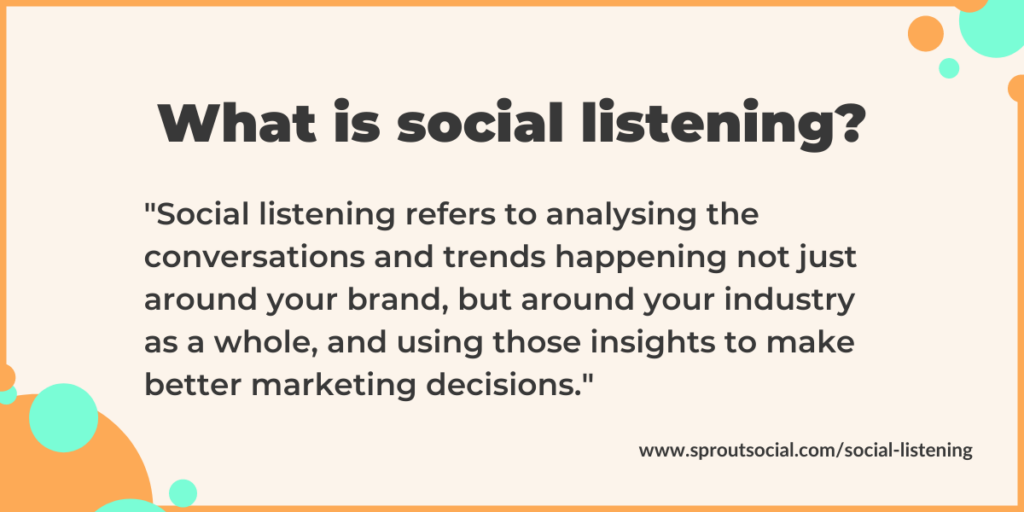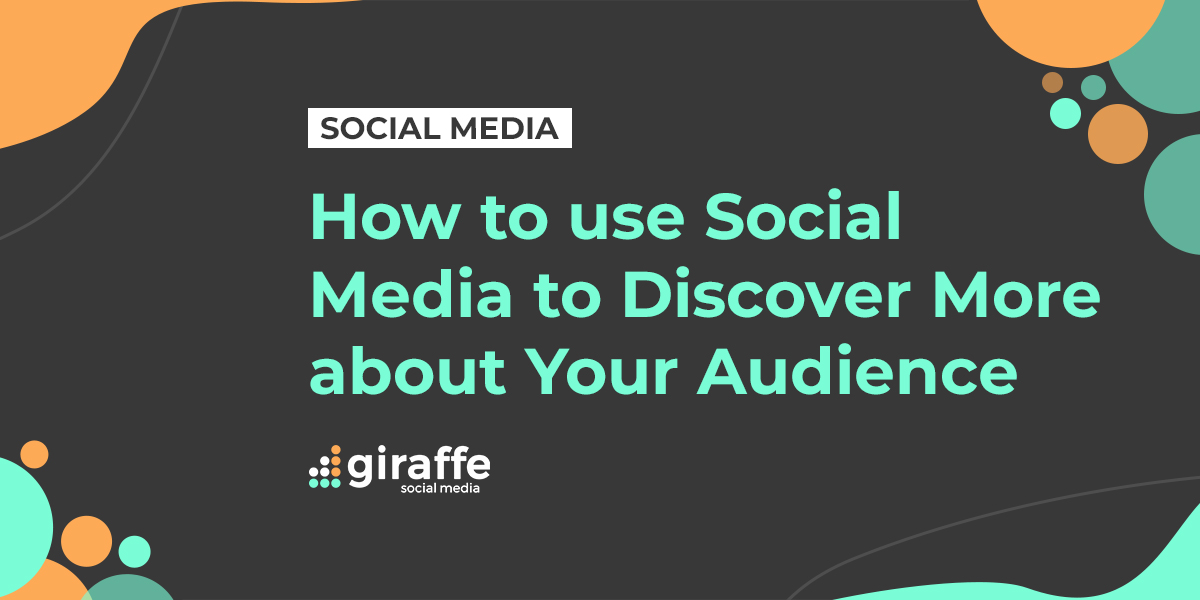One of the best ways to move forward with your social media strategy is to have a clear understanding of your target audience. Social media is the perfect platform for discovering insights about your target audience, such as where they’re most active and what they care about. When you have greater knowledge of your social media audience, you put yourself in a far better position to succeed in growing and optimising your social media presence, as well as applying your findings to other marketing channels.
Social listening is great for finding out the habits of your potential and returning customers by analysing “the conversations and trends happening not just around your brand, but around your industry as a whole, and using those insights to make better marketing decisions.” Not only does this kind of information allow you to tailor your social media content and advertising for better results, but it can also give you valuable direction to the sort of users you should be targeting with your content and promotions.

It’s not uncommon for businesses to realise that they have been targeting the wrong social media audience all along. Here are a few ways to use social media to discover more about your audience:
Identify your ideal customer/buyer persona
If you haven’t already, identify your ideal customer/buyer persona – this is a key segment of your target audience. You may have multiple buyer personas for different products, services, or areas of your business. There are several ways to perform buyer persona research: examine your existing contacts database; capture important information via form fields on your website forms; gain your sales team’s insight into your target customer; and interview current customers/prospects to discover their likes and dislikes.
After performing this research, you can then identify your buyer persona’s basic demographic information; this information will be key when conducting social listening on your target audience.
Find out where your audience is most active
The next step to analysing your target audience on social media is finding out which social media platforms they use most. You may have already identified these platforms when first starting your social media presence, however, social media changes all the time and it’s best to stay up to date with current data.
Cross-reference your target audience demographics with typical social media usage statistics. Facebook has almost 3 billion active users, while YouTube follows behind with 2.2 billion – with numbers as large as these, it’s likely – but not guaranteed – that you’ll find your target audience on these platforms. On Instagram, the majority of its 1 billion monthly active users are aged 18-49, with slightly more women than men. Shopping is a key reason for using the app – 83% of Instagram users “say they discover new products and services on Instagram.”
TikTok also has 1 billion monthly active users, over 130 million of which are in the US. 60% of TikTok users are in Gen Z (born 1997 – 2012), making this the platform to be on if your target demographic is Gen Z.
The largest segment of users on Twitter (based on advertising audience data) is 25-34-year-olds, with men in this group coming out as the largest Twitter age demographic at 19% – almost twice the number of women in the same age range. 18-24-year-olds on the platform, on the other hand, are equally split between men (12%) and women (12%).
B2B brands will almost certainly find their target audience on LinkedIn; 40% of B2B marketers surveyed by eMarketer named LinkedIn as their most effective digital marketing channel for gaining high-quality leads.
Look into your audience insights
Several social media platforms include built-in insights into your audience’s demographics and behaviour. There is no one-size-fits-all on social media, so you’ll need to look at your analytics on a platform-by-platform basis. Your audience is likely to differ between platforms, so tailor your social media audience analysis to each platform for best results.
By keeping track of the most rapidly developing areas in your insights, you can target your campaigns accordingly. Alongside your marketing databases, this information can be useful for location-focused small businesses (such as cafes, restaurants, and hotels in rural areas). It allows you to recognise where the majority of your audience comes from.
Insights and Analytics per Platform
Each platform has its own way of dealing with analytics and insights into your profile. For each of the major networks, here’s where you’ll need to look:
- Facebook: Facebook Page Insights help you to “understand how people are engaging with your Page, view metrics about your Page’s performance, learn which posts have the most engagement and see when your audience is on Facebook.” Once you have data for over 100 people, you may see demographic insights such as age, gender, and location.
- Instagram: Instagram Insights include recent highlights/notable increases in performance, an overview of accounts reached and engaged, follower trends, the content you’ve shared. You can also view insights per post for a more granular breakdown. Instagram Insights require a business or creator account.
- Twitter: Twitter Analytics shows you “how your audience is responding to your content, what’s working, and what’s not” through a monthly “report card.”
- TikTok: TikTok Pro users may see analytics for their accounts, including followers, video views, and profile views.
- YouTube: YouTube Studio shows you analytics to “better understand your video and channel performance with key metrics and reports,” such as reach, views, engagement, audience demographics, revenue, and more.
- LinkedIn: LinkedIn Page Analytics allow you to view metrics such as content effectiveness, demographics/sources of followers, demographics/sources of visitors, competitor comparison, employee advocacy, and engagement with career pages.
Take a look at users’ content
It’s a good idea to put some time aside to delve deeper into the sort of content that dominate the profiles of your audience. If you seek out overlaps in the content your audience shares and engages with, you can tailor your marketing strategy accordingly. You may find that videos perform well in your industry because they’re engaging yet convey a lot of information. Or perhaps your target audience can’t get enough TikTok and Instagram Reels, with snappy short-form content reigning in your industry.
Ultimately, using this research to inform your content strategy will likely improve your engagement rates as you tap into your audience’s likes and preferences. This isn’t to say you should copy your competitors, rather you should use industry trends and patterns to inform your original, high-quality content.
Monitor the dialogues that they contribute to
Through analysing the social media dialogues that members of your audience contribute to, you can begin to develop your own interaction techniques. By getting your brand involved in these conversations you set yourself up to reach more users who could potentially become your audience.
You should also be speaking to your audience on their level, using similar language and ways of writing to convey messages to your audience. Social listening will help you discover the best ways to do this, including the language to use and tone of voice to develop. You want your brand to be able to join a conversation with your target audience naturally without it looking too forced or sales-driven.
Editor’s note: This article was last edited in 2019 and has been updated for accuracy and relevance in November 2021.






